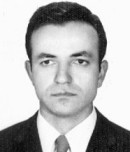
Plenary Lecture
Authentication And Secure Robot Communication

Professor Evangelos A. Yfantis
Director of the ICIS Laboratory
Professor of Computer-Robot-Machine-Vision and Machine Intelligence
Computer Science Department
Engineering College of the University of Nevada
USA
E-mail: yfantis@cs.unlv.edu
Abstract: The majority of industrial, educational, medical and other robots have internet connection for wireless communication to their file server, and communication with one another. Wireless communication makes the devices vulnerable to hacker attacks, considering that many of these devices often times are not well protected. Hackers therefore target robots and use them as an entry point to the robot’s organization network in order to either obtain scientific and technical information illegally, or cause distraction to the organizational network. We provide a method for secure wireless communication in this case with secret key distribution along with confidentiality and authentication. Our system includes public private key cryptography along with session key generation and symmetric key cryptography. The Public private key is generated using elliptic curves y2=x3+ax2+b mod p where 0≤x,y≤p-1 and 1≤a,b≤p-1. The coefficients a, b are chosen so that the genus 1 elliptic curve expressed by the Weierstrass equation is nonsingular and therefore satisfies the condition 4a3+27b2≥0 p is chosen to be a 256-bit prime number, thus we developed 512 software bit registers in our board to perform 256 bit multiplications and divisions.
Brief Biography of the Speaker: E. A. Yfantis, is the director of the ICIS lab. And a full professor of Computer Science, which is part of the Engineering College at the Unversity of Nevada, Las Vegas. Dr. Yfantis is the author of over 200 reseach papers and technical reports in the areas of Computer Science, Information theory, Internet Intelligence, Signal Processing, Communication, Statistical Pattern Recognition, Probability theory, Statistics, Ocean Engineering, Aerodynamics, Electrical Engineering, Medicine, Visualization, Enviromental Protection, and Chemometrics. He has been a consultant for NASA, Los Alamos Scientific Laboratory, Sandia Laboratories, Lawrence Livermore Laboratories, EG&G, Naval Ocean System Center in Santiego California, Corps of Engineers U.S. Army, Lockheed Engineering and Aerospace, Northrop, NSTeC, U.S. EPA, U.S. Department of Energy, SGI, Exxon Corporation, Shell Oil Company, Bedix Corporation, Nevada Gaming Control Board, and many other companys in the US and Canada. His Education includes: Computer Science, Mathematics, Signal Processing, Statistics, Aeronautics, Ocean Engineering, and Electrical Engineering. He was educated at the Universities of: Athens Greece, Rutgers University in New Brunswick, N.J. U.S.A., New Jersey Institute of Technology, Newark, N.J., Fairleigh Dickinson University, Teaneck, N.J., U.S.A., University of Wyoming, Laramie, U.S.A., Columbia University in N.Y., N.Y., U.S.A, the University of Delaware, Newark, Delaware, U.S.A., School of Aeronautics in Teteboro N.J., U.S.A. He holds a Pilot’s License, and is a certified Scuba Diver by PADI. Hi current research interests are Computer-Robot Vision, Machine Vision, Machine Intelligence, Statistical Pattern Recognition, and Multimedia Communication.